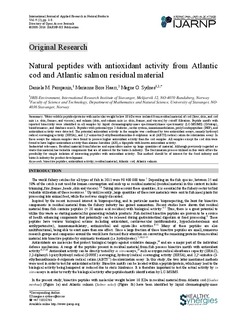| dc.contributor.author | Pampanin, Daniela M. | |
| dc.contributor.author | Haar, Marianne Bore | |
| dc.contributor.author | Sydnes, Magne Olav | |
| dc.date.accessioned | 2016-03-17T14:38:19Z | |
| dc.date.available | 2016-03-17T14:38:19Z | |
| dc.date.issued | 2016-03 | |
| dc.identifier.citation | Pampanin, D.M., Haar, M.B, Sydnes, M.O. (2016) Natural peptides with antioxidant activity from Atlantic cod and Atlantic salmon residual material. International Journal of Applied Research in Natural Products, 9(2), 1-8 | nb_NO |
| dc.identifier.issn | 1940-6223 | |
| dc.identifier.uri | http://hdl.handle.net/11250/2382437 | |
| dc.description.abstract | Summary. Water-soluble peptides/proteins with molecular weight below 10 kDa were isolated from residual material of cod (liver, skin, and cod
mix i.e. skin, frames, and viscera), and salmon (skin, and salmon mix i.e. skin, frames, and viscera) by cut-off filtration. Peptide motifs with
reported bioactivity were identified in all samples by liquid chromatography-mass spectrometry/mass spectrometry (LC-MS/MS) (Orbitrap),
bioinformatics, and database search. Peptides with potential type 2 diabetes, cardio system, immunomodulation, prolyl endopeptidase (PEP), and
antioxidant activity were detected. The potential antioxidant activity in the samples was confirmed by two antioxidant assays, namely hydroxyl
radical scavenging activity (HRSA), and 2,2'-azino-bis(3-ethylbenzothiazoline-6-sulphonic acid (ABTS) radical cation decolorization assay. In
these assays the salmon samples were found to possess higher antioxidant activity than the cod samples. All samples except the cod skin were
found to have higher antioxidant activity than alanine-histidine (AH), a dipeptide with known antioxidant activity.
Industrial relevance. Residual material from fisheries and aquaculture makes up large quantities of material. Although previously regarded as
waste this material has valuable components that are of interest for the biotech industry. The fractionation process utilized in this work offers the
possibility for simple isolation of interesting peptides with antioxidant activity. This method should be of interest for the food industry and
biotech industry for product development. | nb_NO |
| dc.language.iso | eng | nb_NO |
| dc.publisher | Healthy Synergies Publications | nb_NO |
| dc.subject | bioactive peptides | nb_NO |
| dc.subject | antioxidant activity | nb_NO |
| dc.subject | residual material | nb_NO |
| dc.subject | Atlantic cod | nb_NO |
| dc.subject | Atlantic salmon | nb_NO |
| dc.subject | peptider | nb_NO |
| dc.subject | laks | nb_NO |
| dc.subject | torsk | nb_NO |
| dc.subject | fiskerinæringen | nb_NO |
| dc.title | Natural peptides with antioxidant activity from Atlantic cod and Atlantic salmon residual material | nb_NO |
| dc.type | Journal article | nb_NO |
| dc.type | Peer reviewed | nb_NO |
| dc.rights.holder | ©2008-2016. IJARNP-HS Publication | nb_NO |
| dc.subject.nsi | VDP::Mathematics and natural science: 400::Basic biosciences: 470 | nb_NO |
| dc.source.pagenumber | 1-8 | nb_NO |
| dc.source.volume | 9 | nb_NO |
| dc.source.journal | International Journal of Applied Research in Natural Products | nb_NO |
| dc.source.issue | 2 | nb_NO |
